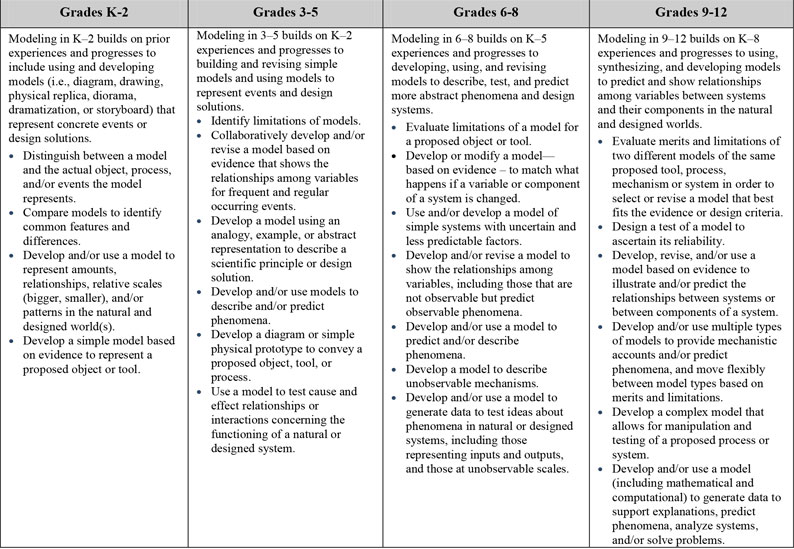Science
Science often involves the construction and use of a wide variety of models and simulations to help develop explanations about natural phenomena. Models make it possible to go beyond observables and imagine a world not yet seen. Models enable predictions of the form “if . . . then . . . therefore” to be made in order to test hypothetical explanations.
Engineering
Engineering makes use of models and simulations to analyze existing systems so as to see where flaws might occur or to test possible solutions to a new problem. Engineers also call on models of various sorts to test proposed systems and to recognize the strengths and limitations of their designs. (Framework, p. 50)
See A Framework for K-12 Science Education, 2012, p. 56 for the entire text for Practice 2: Developing and using models.
In the video below from BozemanScience.com, Paul Andersen explains the importance of modeling in science and engineering. Models are used by scientists to explain phenomenon. Unlike mental models, conceptual models can be shared by all scientists to improve our understanding of the Universe. Engineers use models study systems and test designs.
Developing & Using Models Progression through Gradebands:

Progression from NGSS Appendix F p. 6.
Activities
Five Conceptual Change Activities are included to help teachers and students Confront Beliefs:
- Developing & Using Models Activity #1: Syringe and Plunger
- Developing & Using Models Activity #2: Create Your Own Water Cycle
- Developing & Using Models Activity #3: Build-a-Bug
- Developing & Using Models Activity #4: The Goldilocks Principle: A Model of Atmospheric Gases
- Developing & Using Models Activity #5: Measuring Albedo and Climate Modeling
Also refer to Student Work in the Practice for real-life examples of how MPRES teachers have applied this Practice.
The purpose of the activities is to engage teachers in the Practice of developing and using models. The emphasis is NOT on the activity itself, but rather the conceptual change related to the Practice. Consumers of this Toolkit are reminded not to get wrapped up in the activity, but rather continually reflect on the conceptual nature of the Practice to gain deeper understanding.
Since the following activities are NOT lesson plans, in some cases only a brief explanation of the activity has been provided. Professional development facilitators should encourage learners to direct their own investigations and intervene only as needed to redirect.
To facilitate conceptual change throughout each activity, you should consider the following questions. These questions are also repeated at key points in each activity to assist you.
Awareness Questions:
- From the background information, what new awareness do you have about developing and using models?
- In a 3-Dimensional classroom, what would this Practice look like?
- What questions did the background raise for you?
Expose Belief Questions:
- What are your current beliefs about this practice?
- In what ways do you think you are using this practice?
- What challenges do you see to using this practice?
Debrief activities by focusing on the conceptual understanding of the practice using the following prompts.
Resolve Belief Questions:
- In what ways did this activity change your beliefs about developing and using models?
- How difficult do you find it to develop and use models?
- Discuss your level of confidence along the process of developing and using models.
Extend the Concept Questions:
- How do you currently help students develop and use models of science phenomenon in your classroom?
- Review a recent lesson you taught and evaluate the effectiveness of engaging students in developing and using models.
- What is the relationship between this practice and others?
Go Beyond Questions:
- Ask a colleague to observe one of your lessons OR video yourself teaching and tally the number of questions YOU ask and the number of questions STUDENTS ask.
- Use the EQuiP Rubric for Lessons & Units: Science (PDF format) to evaluate a recent science lesson you taught.


